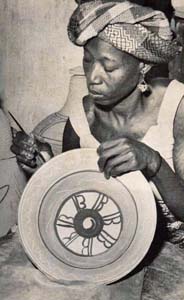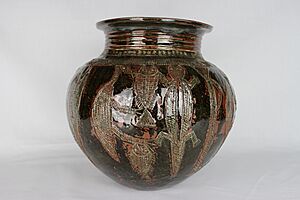Ladi Kwali facts for kids
Quick facts for kids
Ladi Kwali
|
|
|---|---|

Ladi Kwali, OON, NNOM, MBE
|
|
| Born |
Ladi Kwali
1925 Kwali, Northern Region, colonial Nigeria
|
| Died | 12 August 1984 (aged 58–59) |
| Occupation | potter |
Ladi Kwali (around 1925 – August 12, 1984) was a famous Nigerian potter, ceramic artist, and teacher. She was known for her beautiful pots and for combining traditional African pottery with modern techniques. Her work helped bring Nigerian art to the world stage.
Ladi Kwali was born in the village of Kwali in the Gwari area of Northern Nigeria. In her village, women traditionally made pottery. She learned how to make pots as a child from her aunt. She used a method called coiling, where she built pots by stacking coils of clay.
She made large pots for water, cooking, and storage. Ladi Kwali decorated her pots with amazing patterns. These included geometric shapes and drawings of animals like scorpions, lizards, and snakes. Her pots were admired for their beautiful shapes and designs. She became well-known in her region for her talent. The Emir of Abuja, Alhaji Suleiman Barau, even bought some of her pots. This is where Michael Cardew first saw her work in 1950.
Contents
Early Life and Pottery Skills
Ladi Kwali was born in Kwali village, which is now part of the Federal Capital Territory. Some historians say she was born in 1925, while others suggest 1920. Her family had a long tradition of making pottery. Her younger brother, Mallam Mekaniki Kyebese, said that Ladi Kwali was very good at pottery even when she was young. Her pots often sold out before they even reached the market!
In her early career, Ladi Kwali made pots that showed her Gbagyi culture. She also added her own unique style. Her pottery designs often showed a sense of balance and order.
Her Pottery Career
In 1951, Michael Cardew became the Pottery Officer for the Nigerian Government. He opened the Pottery Training Centre in Suleja (then called "Abuja") in 1952. In 1954, Ladi Kwali joined this center. She was the first woman potter to work there.
At the center, she learned new ways of making pottery. She learned to use a potter's wheel, how to apply glaze (a shiny coating), and how to fire pots in a kiln (a special oven). She also learned to use slip, which is liquid clay. Eventually, she became a teacher at the center. She made bowls with a special decoration called sgraffito. This involved dipping pots in colored slip and then scratching designs through it.
By 1965, four more women from the Gwari area joined the center. These women were Halima Audu, Lami Toto, Assibi Iddo, and Kande Ushafa. They worked together in a workshop they called Dakin Gwari, meaning "the Gwari room." There, they continued to hand-build large water pots.
Unique Design Style
The women used natural tools like snail shells or calabash rinds to shape and smooth the inside of their pots. They also used their traditional designs, adding a white clay mixture (kaolin and feldspar slip) into the patterns. When these pots were fired with a clear celadon glaze, the white slip areas turned pale green. This created a beautiful contrast with the dark green or reddish-brown clay.
Because these hand-built, decorated pots were glazed and fired in a hot kiln, they blended traditional Gwari art with Western studio pottery. Ladi Kwali's most famous pots were made from stoneware clay. They often had lizard patterns and a dark, shiny glaze. This dark glaze made the pots look very "African" to people in Western countries.
She also made patterns by rolling small tools made of twisted string or notched wood over the clay. These tools created lines and designs on the pot's surface. This ancient technique dates back to the neolithic period. Traditionally, these pots were fired in bonfires of dry plants.
Exhibitions and Shows
Ladi Kwali's pottery became famous as "art objects." Her pots were shown in international exhibitions of Abuja pottery in 1958, 1959, and 1962. These shows were organized by Michael Cardew. In 1961, Kwali gave live demonstrations in Great Britain, showing how she made her pots. She also gave demonstrations in France and Germany. In 1972, she traveled to America with Cardew. Her work was highly praised when shown in London at the Berkeley Galleries. In the early 1980s, the Abuja Pottery was renamed the Ladi Kwali Pottery in her honor.
Awards and Achievements
Ladi Kwali received many honors for her amazing work:
- In 1954, her pots were featured in the International exhibition of Abuja pottery.
- She was awarded an MBE (Member of the Order of the British Empire) in 1963. This is a special award from the British government.
- In 1977, she received an honorary doctoral degree from Ahmadu Bello University in Zaria. This means the university recognized her as highly educated, even without attending classes.
- In 1980, the Nigerian Government gave her the Nigerian National Order of Merit Award (NNOM). This is the highest national honor for academic achievement in Nigeria.
- She also received the national honor of the Officer of the Order of the Niger (OON) in 1981.
- Her picture is on the back of the Nigerian 20 Naira banknote, which is like a paper money bill.
- A major street in Abuja is named Ladi Kwali Road.
- The Sheraton Hotel in Abuja has a large conference center called the Ladi Kwali Convention Center.
- Her artworks are kept in museums and collections around the world. These include the Smithsonian National Museum of African Art in the USA, the Victoria and Albert Museum in the UK, and the Aberystwyth University Ceramics Gallery in the UK.
- In 2022, a big exhibition called Body Vessel Clay, Black Women, Ceramics & Contemporary Art featured Ladi Kwali's work. It showed how she influenced many Black female artists.
- The Google Doodle on March 16, 2022, honored Ladi Kwali.


